
Timeline:
1917-34: The Jazz Age and the Harlem Renaissance
| 1917 Racial antagonism toward African Americans newly employed in war industries leads to riots that kill 40 blacks and 8 whites in East St. Louis, Illinois. | ||
| 1918 James Van Der Zee and his wife open the Guarantee Photo Studio in Harlem. The portraits he shoots later become a treasured chronicle of the Harlem Renaissance. | ||
| 1919 During the "Red Summer" following World War I, 13 days of racial violence on the South Side of Chicago leave 23 blacks and 15 whites dead, 537 people injured, and 1,000 black families homeless. | ||
| 1919 A'Lelia Walker inherits the family business and estate upon the death of her mother, Madame C.J. Walker. In the 1920s she entertains the leading writers and artists of the Harlem Renaissance. | ||
| 1920 Marcus Garvey, leader of the Universal Negro Improvement Association, addresses 25,000 blacks at Madison Square Garden and presides over a parade of 50,000 through the streets of Harlem. | ||
| 1920 The Negro National League, first of baseball's Negro leagues, is established. | ||
| 1921 Oscar Charleston, perhaps the best all-around baseball player in the history of the Negro leagues, leads his league in doubles, triples, and home runs, batting .434 for the year. | ||
| 1921 Shuffle Along, a musical by Eubie Blake and Noble Sissle, opens on Broadway. It is the first musical written and performed by African Americans. | ||
| 1922 Louis Armstrong leaves New Orleans, arriving in Chicago to play second trumpet in cornetist King Oliver's Creole Jazz Band. Armstrong's work in the 1920s would revolutionize jazz. | ||
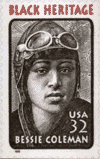 | 1922 Aviator Bessie Coleman, who later refuses to perform before segregated audiences in the South, stages the first public flight by an African American woman. | |
| 1923 Charles Clinton Spaulding becomes president of the North Carolina Mutual Life Insurance Company. He builds it into the nation's largest black-owned business by the time of his death in 1952. | ||
| 1923 Pianist and orchestrator Fletcher Henderson becomes a bandleader. His prestigious band advances the careers of African American musicians such as Louis Armstrong, Coleman Hawkins, and Roy Eldridge. | ||
| 1923 Poet and novelist Jean Toomer publishes his masterpiece, Cane, an experimental novel often considered one of the greatest achievements of the Harlem Renaissance. | ||
| 1923 Blues singer Bessie Smith, discovered by pianist-composer Clarence Williams, makes her first recording. She will eventually become known as "Empress of the Blues." | ||
| 1924 Spelman Seminary, which began awarding college degrees in 1901, becomes Spelman College. The school began in 1881 with two Boston women teaching 11 black women in an Atlanta, Georgia, church basement. | ||
| 1924 At a dinner sponsored by Opportunity magazine, black writers and white publishers mingle; the event is considered the formal beginning of the Harlem Renaissance, or New Negro movement. | ||
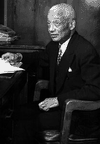 | 1925 The New Negro, an anthology of fiction, poetry, drama, and essays associated with the Harlem Renaissance, is edited by Alain Locke. | |
| 1925 Singer and dancer Josephine Baker goes to Paris to dance at the Théâtre des Champs-Élysées in La Revue nègre, becoming one of the most popular entertainers in France. | ||
| 1925 Countee Cullen, one of the finest poets of the Harlem Renaissance, publishes his first collection of poems, Color, to critical acclaim before graduating from New York University. | ||
| 1925 In an era when Ku Klux Klan membership exceeds 4,000,000 nationally, a parade of 50,000 unmasked members takes place in Washington, D.C. | ||
| 1925 A. Philip Randolph, trade unionist and civil-rights leader, founds the Brotherhood of Sleeping Car Porters, which becomes the first successful black trade union. | ||
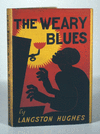 | 1925 At a historic literary awards banquet during the Harlem Renaissance, Langston Hughes earns first place in poetry with The Weary Blues, which is read aloud by James Weldon Johnson. | |
| 1926 The literary journal Fire!!, edited by young writer Wallace Thurman, publishes its first and only issue. The short-lived publication remains highly influential among the participants of the Harlem Renaissance. | ||
| c. 1926 Pianist, composer, and self-proclaimed inventor of jazz Jelly Roll Morton records several of his masterpieces, including "Black Bottom Stomp" and "Dead Man Blues." | ||
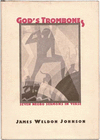 | 1927 James Weldon Johnson, poet and anthologist of black culture, publishes God's Trombones, a group of black dialect sermons in verse accompanied by the illustrations of Aaron Douglas. | |
| 1927 Poet and playwright Angelina Weld Grimké publishes Caroling Dusk, an anthology of her poetry edited by Countee Cullen. | ||
| 1927 Painter Henry Ossawa Tanner, whose works include The Two Disciples at the Tomb, becomes the first African American to be granted full membership in the National Academy of Design. | ||
| 1927 Singer and actor Ethel Waters makes her first appearance on Broadway in the all-black revue Africana. | ||
| 1927 The all-black professional basketball team known as the Harlem Globetrotters is established. | ||
| 1928 Poet and novelist Claude McKay publishes Home to Harlem, the first fictional work by an African American to reach the best-seller lists. | ||
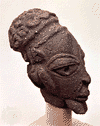 | 1928 Evidence of the ancient Iron Age Nok culture is discovered on Nigeria's Benue Plateau. | |
| 1929 John Hope, noted advocate of advanced liberal arts instruction for blacks, is chosen as president of Atlanta University, the first graduate school for African Americans. | ||
| 1931 Nine black youths accused of raping two white women on a freight train go on trial for their lives in Scottsboro, Alabama. The case becomes a cause célèbre among Northern liberal and radical groups. | ||
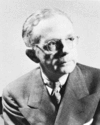 | 1931 Walter White begins his tenure as executive secretary of the NAACP, his principal objective being the abolition of lynching. In the early decades of the 20th century, there were often more than 60 lynchings nationally each year. By the time of White's death in 1955, lynchings would become a rarity. | |
| 1932 In Tuskegee, Alabama, the U.S. Public Health Service begins examining the course of untreated syphilis in black men, not telling them of their syphilis or their participation in the 40-year study. | ||
| 1932 Wallace Thurman, young literary rebel of the Harlem Renaissance, publishes his satiric novel Infants of the Spring. | ||
| 1934 Wallace D. Fard, founder of the Nation of Islam movement, disappears, leading to the rise of Elijah Muhammad. | ||

| Copyright © 2005 Encyclopædia Britannica, Inc. |